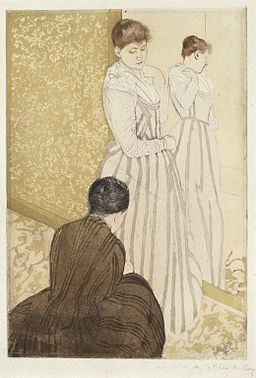Ever have one of those experiences where you think you know what you’re doing, and before you know it, you’re in over your head? I recently bought a new dress online to wear to a friend’s wedding. Unfortunately, I failed to pay sufficient attention to the measurements given: it pooled on the floor at my feet.

Not to worry, said I to myself, said I: I can take the hem up. I had taken hems up before: a pencil skirt for work, a dress that was a tad too long – even my wedding dress. But there was, I found, a difference with this dress. Yes, it was already hemmed, but being a light, loose fabric it stretched with the application of gravity (unevenly, of course – not everything is exactly on the bias). I couldn’t depend on the existing hem as a guideline.
I turned, therefore, to another recent acquisition: a book entitled The Complete Book of Sewing by Constance Talbot. It’s a general reference on dressmaking, dressing, millinery and household sewing such as upholstery and curtains. It has a lot to say about hems, but the part which particularly caught my attention was the section on “How to Hang a Skirt” – not, as you might think, how to put it away in the wardrobe, but how to mark where the hem should be; presumably called “hanging” a skirt because of the way skirts stretch when hung (it’s that gravity thing again).
There are a number of methods given for finding this line – best done while you are wearing the skirt unless you have an exact body double to hand. (While I do have the exoskeleton, it won’t stand the way I do until I pad the inside to hold at one angle.) The classic method is, of course, to stand on a stool or table and slowly turn while a Helpful Person inserts pins at the desired height. (Inserts pins into the skirt, that is. Not you.)

Of course, this requires the availability of a Helpful Person, and mine was temporarily out of action. Moving on, then to the clever ways of marking a skirt all by yourself. The ideal way is to have a skirt-marking gadget which you set to the desired height. Then all you have to do is squeeze the bulb to have a line of chalk puffed onto your skirt as you turn – see here for visuals. Rather like an automated Helpful Person, but hard to come by these days.
The third option requires no Helpful Person or specialized equipment, other than some tailor’s chalk and a sharp-edged table. You rub the chalk on the edge of the table, and then you press up against it as you turn. Take skirt off, measure down desired length from line, mark hem, voila. In theory. I tried it, and while I didn’t get a usable hem line, I did get tailor’s chalk all over my dress. Fail.
Having now run through all the available methods, I turned to sitting on the stairs and brooding on my incompetence. All right, I hadn’t tried quite all the methods. Jennifer Garner says “You can do a lot with Scotch tape. Almost anything! I love that you can hem a dress,” but no. I was desperate, but not quite Scotch-tape desperate.
 I got sick of being desperate, and sitting on the stairs trying to come up with new ways of measuring a hem, and I went to bed. The next day, I laid the dress out flat and laid a dress with a satisfactory hem over it. They weren’t the same width, but I was still desperate. I pushed on. Then, having marked a line and pinned it up, I put the dress on, climbed on a stool, and besought my Helpful Person (once more in working order) to eyeball it for me. Straight? No.
I got sick of being desperate, and sitting on the stairs trying to come up with new ways of measuring a hem, and I went to bed. The next day, I laid the dress out flat and laid a dress with a satisfactory hem over it. They weren’t the same width, but I was still desperate. I pushed on. Then, having marked a line and pinned it up, I put the dress on, climbed on a stool, and besought my Helpful Person (once more in working order) to eyeball it for me. Straight? No.
I had one last idea. I put the new dress on. Then I put the old dress on – the one with the satisfactory hem. Then my Helpful Person (God bless him!) made a line of pins in the new dress where the old dress came to, and I marked down four centimetres from the line (the new dress being lighter, and lighter dresses looking shorter if a tad too short) and there we had it. A hemline. Phew.
That left only the problem that I had to cut some of the fabric off (which might change the hang of what was left) because there was too much extra to ease into the new hem. Internet to the rescue! I found this advice – with pictures – which not only allowed me to check the hem-length part-way through the operation, but meant I didn’t have to rethread my sewing machine, as the first line of stitching is not visible from the outside. I did the hemstitching by hand, because the dress hem is in two colours, and in any case the hand-hem is less obtrusive. Which is just as well, as my threads weren’t perfect matches.

Then I realized I had quite a bit of fabric left over, so I used it to make a matching kerchief (or Super-Bandanna). By this time the deadline was getting very close, and I ended up sewing on the contrast section by hand in the train on the way to the wedding. While listening to the ladies across the aisle talk about how young people just don’t have sewing skills any more. I thought about ‘accidentally’ rolling my thimble across the floor and retrieving it from amongst their feet, but I decided against it. I have few enough sewing skills: better to keep quiet and look like I know what I’m doing than to open my mouth and show how little I really know.
But at least now I know how to get a good hem (and hemline) on a full, light skirt.









